카바이드 엔드밀 은 뜨거운 칼로 버터를 자르듯 금속을 절단하는 정밀 가공의 숨은 영웅입니다. 금속 가공의 복잡한 디테일에 감탄한 적이 있다면 카바이드 엔드밀이 주연급 역할을 했을 가능성이 높습니다. 하지만 무엇이 그토록 뛰어난 걸까요? 카바이드 엔드밀의 구성과 유형부터 적용 분야, 생산 공정 등에 이르기까지 카바이드 엔드밀의 핵심을 자세히 알아보세요. 이 가이드는 이 놀라운 도구를 선택할 때 정보를 제공할 뿐만 아니라 더 나은 선택을 할 수 있도록 도와줄 것입니다.
카바이드 엔드밀이란?
카바이드 엔드밀은 주로 CNC(컴퓨터 수치 제어) 가공에 사용되는 절삭 공구입니다. 내구성과 내열성으로 잘 알려진 텅스텐 카바이드로 구성되며, 종종 코발트 또는 기타 금속과 결합하여 성능을 향상시킵니다. 정밀하고 날카로우며 없어서는 안 될 기계 가공의 메스라고 생각하면 됩니다.
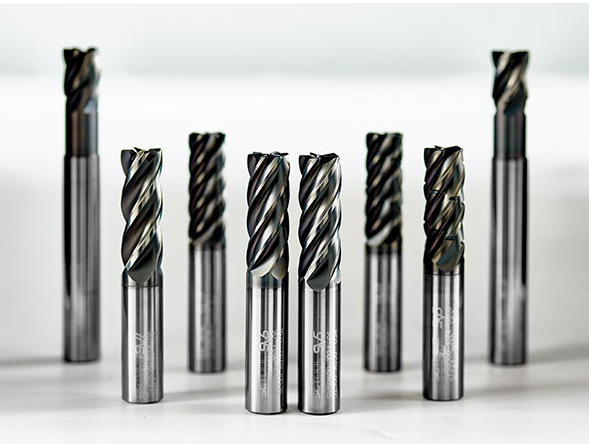
카바이드 엔드밀의 종류
다음은 카바이드 엔드밀의 주요 유형과 고유한 용도를 요약한 표입니다:
| 카바이드 엔드밀 유형 | 설명 | 주요 사용 사례 |
|---|---|---|
| 사각 엔드밀 | 컷의 날카로운 모서리를 위한 평평한 끝. | 슬롯, 플 런지 커팅 및 프로파일링. |
| 볼 노즈 엔드 밀 | 부드러운 곡선과 윤곽을 위해 끝이 둥글게 처리되었습니다. | 3D 윤곽 가공, 금형 제작 및 금형 작업. |
| 코너 반경 엔드밀 | 정사각형 엔드밀과 비슷하지만 모서리가 둥글게 처리되어 있습니다. | 모서리 가공 시 내구성 향상. |
| 황삭 엔드 밀 | 톱니 모양의 절삭날로 재료를 더 빠르게 제거할 수 있습니다. | 고강도 가공, 대량의 자재 제거. |
| 마감 엔드 밀 | 세련된 표면 마감을 위한 부드러운 커팅 엣지. | 고품질 표면을 얻기 위한 최종 패스. |
| 테이퍼 엔드 밀 | 깊은 컷과 복잡한 디테일을 위한 원뿔 모양. | 깊은 금형 및 캐비티 가공. |
| 스레드 밀 | 내부 스레드 절단에 특화되어 있습니다. | 단단한 소재의 정밀 스레딩. |
| 싱글 플루트 엔드 밀 | 칩 간극을 극대화하는 하나의 커팅 엣지. | 플라스틱 및 알루미늄과 같은 부드러운 소재. |
| 멀티 플루트 엔드 밀 | 더 매끄러운 마감을 위한 다중 커팅 엣지. | 정밀한 절단이 필요한 단단한 소재. |
| 코팅 엔드 밀 | 엔드밀은 내구성을 높이기 위해 TiAlN 또는 DLC와 같은 재료로 코팅되었습니다. | 공구 수명이 향상된 고속 가공. |
원료 및 성분 분석 카바이드 엔드밀
카바이드 엔드밀은 주로 인성과 내열성을 겸비한 소재인 텅스텐 카바이드 분말로 만들어집니다. 일반적으로 사용되는 재료는 다음과 같습니다:
- 텅스텐 카바이드 분말: 주요 구조를 형성하여 경도와 내마모성을 제공합니다.
- 코발트: 바인더 역할을 하여 인성을 강화합니다.
- 티타늄 카바이드: 내열성을 향상시킵니다.
- 탄탈륨 또는 니오븀: 고온에서 강도를 높입니다.
이 독특한 조합은 특히 까다로운 환경에서 초경 엔드밀이 고속강(HSS) 공구보다 뛰어난 성능을 발휘하도록 보장합니다.
카바이드 엔드밀의 응용 분야
| 산업 | 특정 애플리케이션 |
|---|---|
| 항공우주 | 가볍지만 튼튼한 부품을 위한 티타늄 합금 절단. |
| 자동차 | 엔진 부품 및 정밀 기어 제조. |
| 의료 | 수술 도구 및 보철물 가공. |
| 전자 제품 | 반도체 및 회로 기판용 소형 부품을 절단합니다. |
| 금형 및 금형 제작 | 플라스틱 및 금속 주조를 위한 복잡한 금형과 금형 제작. |
| 석유 및 가스 | 열악한 고압 환경에 적합한 구성 요소를 제작합니다. |
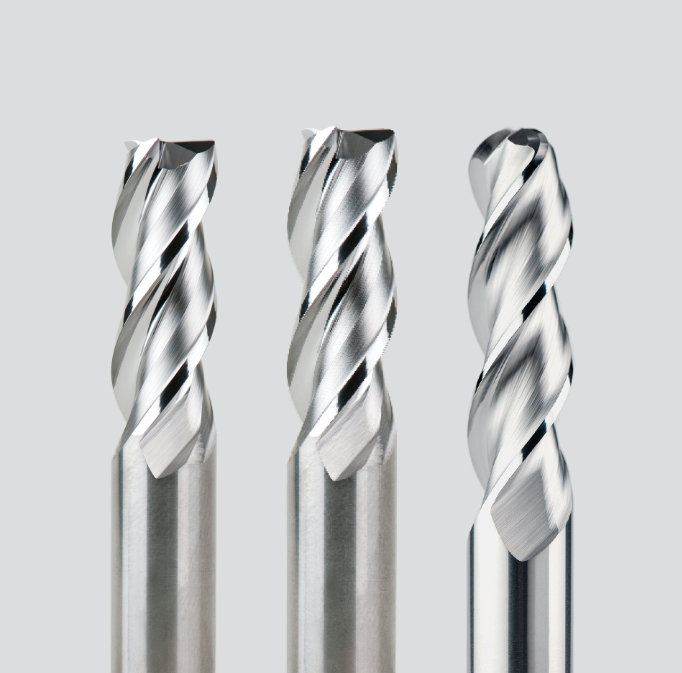
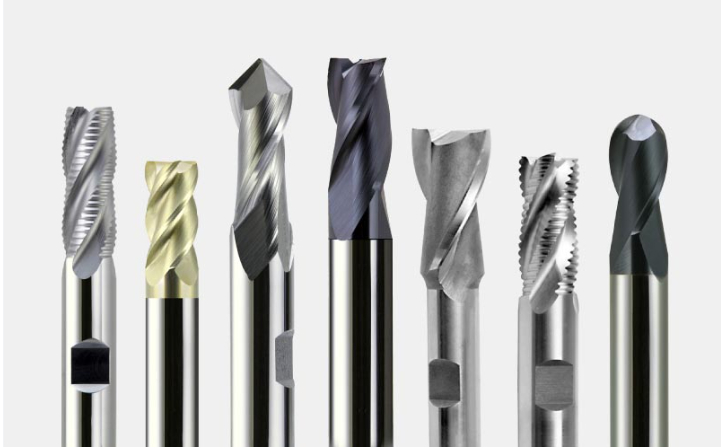
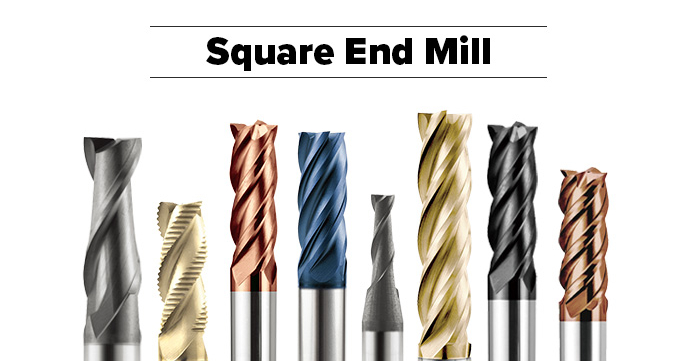
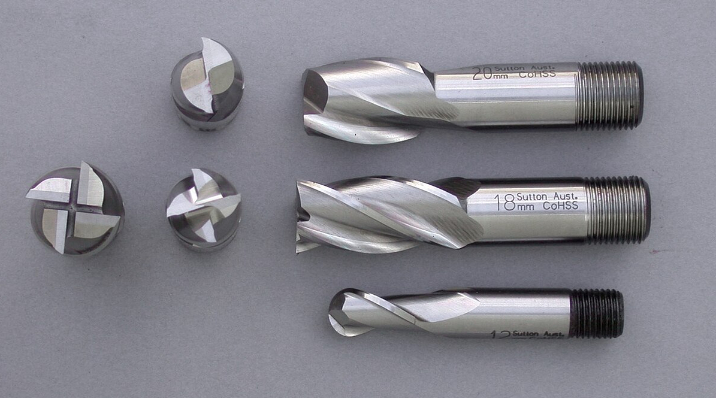

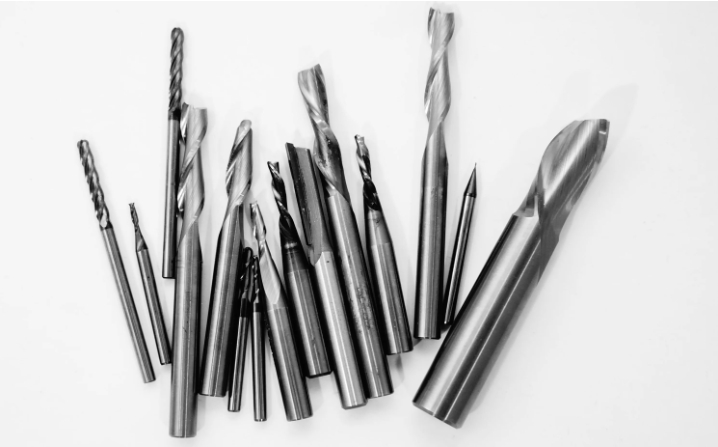
생산 프로세스 흐름 카바이드 엔드밀
카바이드 엔드밀 제조에는 몇 가지 세심한 단계가 필요합니다:
- 분말 혼합: 텅스텐 카바이드 및 기타 원소가 혼합되어 있습니다.
- 압축: 혼합물을 원하는 모양으로 압축합니다.
- 소결: 고온 처리로 소재를 융합합니다.
- 자르기 및 모양 만들기: 원시 블랭크는 정밀한 형태로 연마됩니다.
- 코팅 (선택 사항): 향상된 성능을 위해 특수 코팅이 적용됩니다.
카바이드 엔드밀의 재료 특성
| 속성 | 설명 |
|---|---|
| 경도 | 매우 단단하여 높은 스트레스 상황에서도 긴 공구 수명을 보장합니다. |
| 열 저항 | 격렬한 가공 공정 중 고온을 견뎌냅니다. |
| 내마모성 | 뛰어난 내구성으로 마모와 손상을 줄여줍니다. |
| 힘 | 강철 및 티타늄과 같은 단단한 재료를 절단할 수 있는 높은 압축 강도. |
구성, 속성 및 특성
| 구성 요소 | 역할 | 특성 |
|---|---|---|
| 텅스텐 카바이드 | 주요 성분 | 경도, 내마모성. |
| 코발트 바인더 | 인성 강화제 | 탄력성을 개선하고 취성을 줄입니다. |
| 티타늄 첨가제 | 열 안정성 부스터 | 더 빠른 속도로 가공할 수 있습니다. |
경도, 강도 및 내마모성
| 메트릭 | 가치 | 중요성 |
|---|---|---|
| 경도(HRC) | 89-93 | 스트레스를 받아도 날카로운 모서리를 유지합니다. |
| 압축 강도 | 3000 MPa | 무거운 하중을 변형 없이 처리합니다. |
| 내마모성 | 높음 | 운영 수명을 연장하여 교체 필요성을 줄입니다. |
사양, 크기, 모양 및 표준
| 사양 | 사용 가능한 범위 | 비고 |
|---|---|---|
| 지름 | 0.1mm ~ 20mm | 섬세한 디테일과 무거운 기계 가공에 모두 적합합니다. |
| 길이 | 20mm ~ 150mm | 깊이 요구 사항에 따라 다릅니다. |
| 섕크 유형 | 일자형, 테이퍼형 | 다양한 머신 설정과의 호환성을 보장합니다. |
| 플루트 수 | 1 ~ 12 | 소재 및 마감 요구 사항에 맞게 조정되었습니다. |
올바른 초경 엔드밀 선택
| 기준 | 고려 사항 |
|---|---|
| 절단 중인 재료 | 엔드밀 경도를 재료와 일치시킵니다. |
| 코팅 유형 | 열을 위한 TiAlN, 윤활을 위한 DLC. |
| 플루트 디자인 | 플라스틱용 싱글 플루트, 스틸용 멀티 플루트. |
| 절단 속도 | 속도가 빠를수록 코팅된 도구가 필요합니다. |
| 예산 | 비용과 성능의 균형을 맞추세요. |
의 장점과 한계 카바이드 엔드밀
| 장점 | 제한 사항 |
|---|---|
| 탁월한 내구성 | HSS 도구에 비해 초기 비용이 높습니다. |
| 내열성 및 내마모성 | 부적절한 사용 시 깨지기 쉽습니다. |
| 다양한 애플리케이션에 활용 가능 | 샤프닝을 위한 특정 장비가 필요합니다. |

공급업체 및 가격 세부 정보
| 공급업체 | 가격 범위 | 주요 기능 |
|---|---|---|
| 케나메탈 | $50 – $300 | 고품질 코팅, 다양한 범위. |
| Seco 도구 | $60 – $400 | 항공우주 및 자동차에 특화되어 있습니다. |
| 샌드빅 | $70 – $350 | 고속 가공에서 탁월한 성능을 발휘합니다. |
자주 묻는 질문
| 질문 | 답변 |
|---|---|
| 왜 HSS 공구 대신 카바이드를 선택해야 할까요? | 카바이드 공구는 수명이 길고, 더 빠른 속도를 처리하며, 마모에 강합니다. |
| 목재에 카바이드 엔드밀을 사용할 수 있나요? | 네, 하지만 지나친 표현입니다. HSS 도구는 목재에도 잘 작동합니다. |
| 고열에 가장 적합한 코팅은 무엇인가요? | TiAlN과 AlCrN은 열 집약적인 애플리케이션에 탁월합니다. |
| 코팅 엔드밀은 그만한 가치가 있을까요? | 특히 고속 또는 마모성 소재 가공의 경우 더욱 그렇습니다. |




